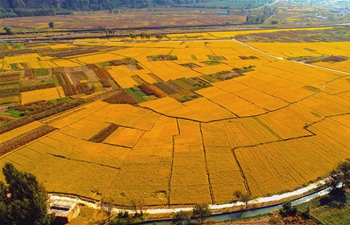URUMQI, Oct. 3 (Xinhua) -- On a large patch of fiery red field, several harvesters are reaping chilies, and a farmer surnamed Guo phones for a truck to load them. It has happened much quicker than he expected due to a new batch of harvesting machines.
The latest-generation chili harvester works fast. Really fast. In just two hours, 1.5 hectares of red field turned green.
The small town of Anjihai in northwest China's Xinjiang Uygur Autonomous Region boasts high-quality chilies thanks to its long daylight hours and a fine environment. To farmers like Guo, the tender, spicy fruit brings in half their annual income. So, in harvest season, people waste no time reaping the crops and drying them under the Gobi desert sun. Luckily, today they have machines to buy them time.
As modern agriculture has developed in Anjihai, the harvesters are used in 95 percent of more than 2,600 hectares of chili fields.
Local farmers are good at doing the math. A harvester can reap five to eight hectares of chilies, or 160 to 240 tonnes of chilies, a day, but it needs 400 people and 12 times the money to finish the same amount of work.
Liu Peijun was one of the first farmers to use the chili harvesters in the area. He and several farmers established a cooperative in 2014 to work with the machines.
"It was difficult. Old farmers said we were mad," Liu said.
Liu invited farmers of two villages to watch how fast and neatly the machines worked. Everyone was convinced.
Within four years, the machines were widely used on fields in Anjihai. They help farmers sow, spray insecticide and harvest.
To develop modern agriculture, the local government has been encouraging farmers to team up as cooperatives to plant crops on a larger scale since 2010. As a result, the machines can work on larger fields.
Today farmers are using the fourth-generation harvesters, which are 30 percent more efficient. As machines have replaced people, new jobs have emerged in the town. Apart from harvester driver, technicians are one of the most sought-after jobs.
Technician Zheng Yasheng has started chili harvester work this year. Now he is able to modify an old harvester to make it almost as good as the latest model.
"Every coin has two sides," Liu said. "In the past we needed the whole village to grow chilies. Now five people will do."
As many jobs were "stolen" by the machines, most farmers have gone to work in the cities. But Liu has bigger ambitions. He plans to take 50 fellow villagers, who were liberated from local farm work, to Aksu Prefecture, where he has contracted a vast area of farmland to grow cotton. In Aksu, cotton-picking machines and driverless tractors are also used to ease the burden of farmers.
As an important agricultural region in China, vast, scarcely populated Xinjiang use machines to grow and reap crops on 84 percent of its farmland, playing a leading role in the country's modern agricultural development.

















